Financial Management: Constantine's Grocery Financing Decision Report
VerifiedAdded on 2022/11/23
|7
|1432
|271
Report
AI Summary
This report, prepared for Constantine's grocery, analyzes two primary methods of raising capital: issuing corporate bonds and conducting a public offering. It begins by defining corporate bonds as promissory notes used to secure funds, detailing the requirement for interest payments and various bond types. The report then outlines the IPO process, including the role of investment bankers, critical business reviews, SEC filings, and share pricing. It proceeds to compare the impacts of each alternative, highlighting the implications of regular interest payments versus shareholder dividends, and the effects on company control, financial disclosure, financial reporting, and future earnings. The report also examines the influence of stockholders on management decisions. Ultimately, the report recommends a public offering as the more sustainable option for long-term development, providing detailed insights into both financing methods to aid informed decision-making.
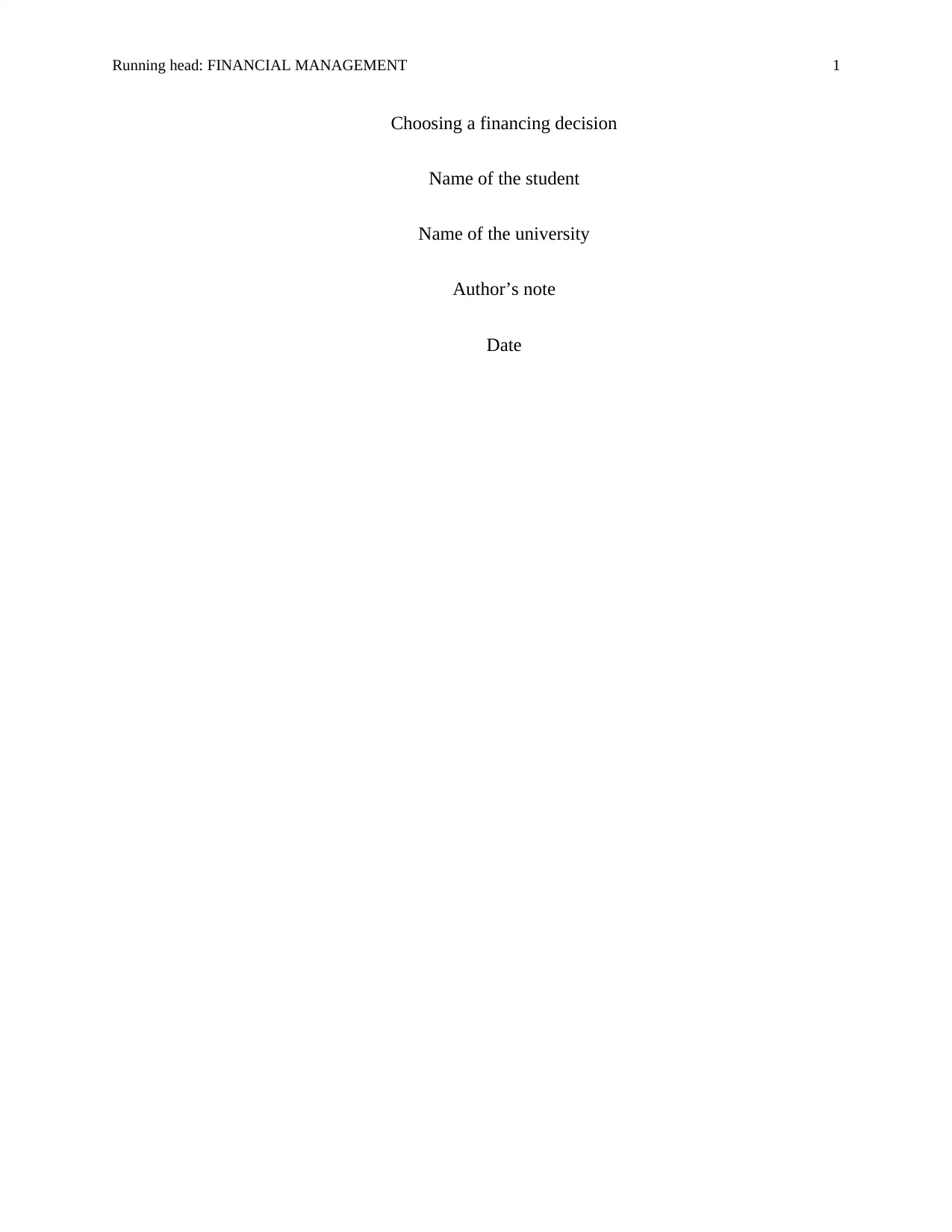
Running head: FINANCIAL MANAGEMENT 1
Choosing a financing decision
Name of the student
Name of the university
Author’s note
Date
Choosing a financing decision
Name of the student
Name of the university
Author’s note
Date
Paraphrase This Document
Need a fresh take? Get an instant paraphrase of this document with our AI Paraphraser
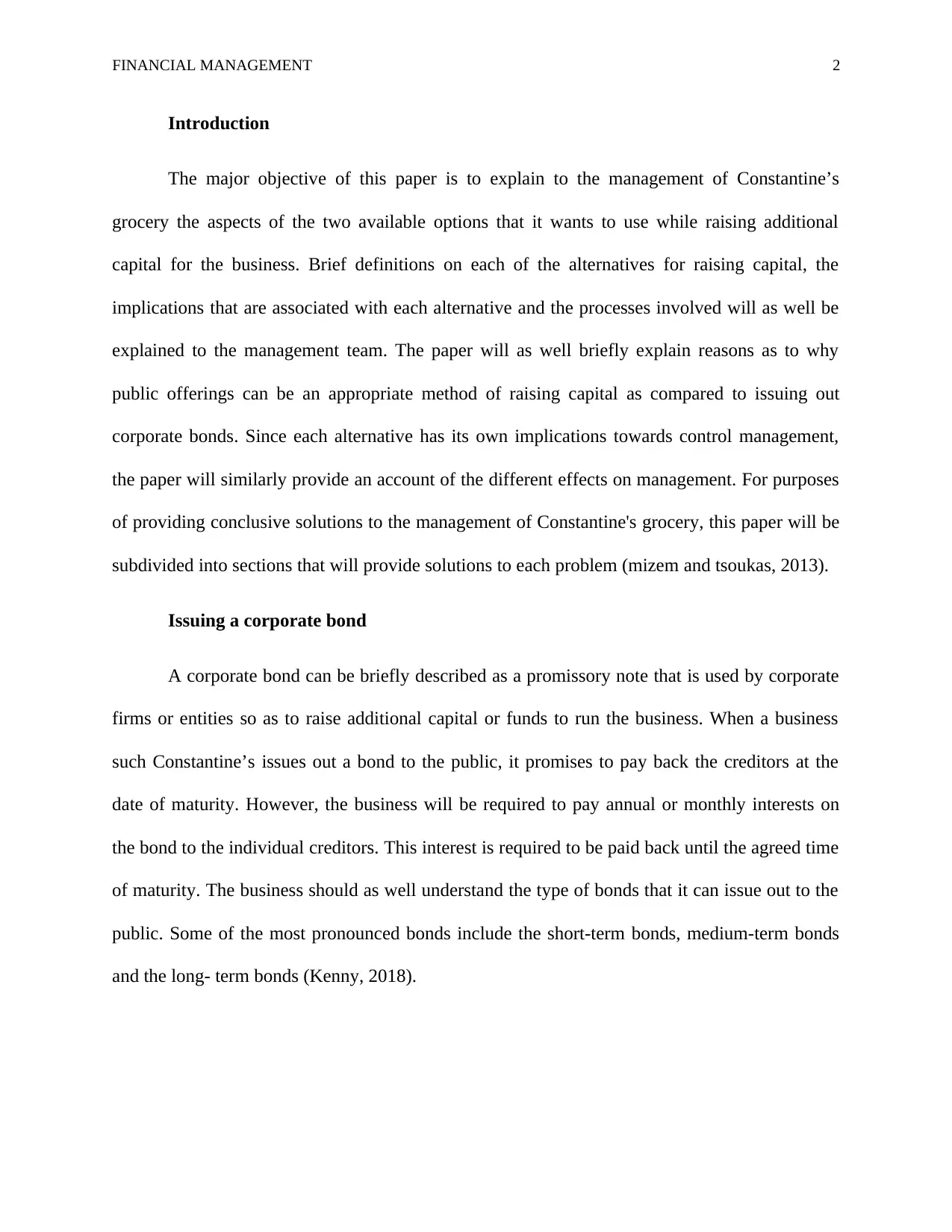
FINANCIAL MANAGEMENT 2
Introduction
The major objective of this paper is to explain to the management of Constantine’s
grocery the aspects of the two available options that it wants to use while raising additional
capital for the business. Brief definitions on each of the alternatives for raising capital, the
implications that are associated with each alternative and the processes involved will as well be
explained to the management team. The paper will as well briefly explain reasons as to why
public offerings can be an appropriate method of raising capital as compared to issuing out
corporate bonds. Since each alternative has its own implications towards control management,
the paper will similarly provide an account of the different effects on management. For purposes
of providing conclusive solutions to the management of Constantine's grocery, this paper will be
subdivided into sections that will provide solutions to each problem (mizem and tsoukas, 2013).
Issuing a corporate bond
A corporate bond can be briefly described as a promissory note that is used by corporate
firms or entities so as to raise additional capital or funds to run the business. When a business
such Constantine’s issues out a bond to the public, it promises to pay back the creditors at the
date of maturity. However, the business will be required to pay annual or monthly interests on
the bond to the individual creditors. This interest is required to be paid back until the agreed time
of maturity. The business should as well understand the type of bonds that it can issue out to the
public. Some of the most pronounced bonds include the short-term bonds, medium-term bonds
and the long- term bonds (Kenny, 2018).
Introduction
The major objective of this paper is to explain to the management of Constantine’s
grocery the aspects of the two available options that it wants to use while raising additional
capital for the business. Brief definitions on each of the alternatives for raising capital, the
implications that are associated with each alternative and the processes involved will as well be
explained to the management team. The paper will as well briefly explain reasons as to why
public offerings can be an appropriate method of raising capital as compared to issuing out
corporate bonds. Since each alternative has its own implications towards control management,
the paper will similarly provide an account of the different effects on management. For purposes
of providing conclusive solutions to the management of Constantine's grocery, this paper will be
subdivided into sections that will provide solutions to each problem (mizem and tsoukas, 2013).
Issuing a corporate bond
A corporate bond can be briefly described as a promissory note that is used by corporate
firms or entities so as to raise additional capital or funds to run the business. When a business
such Constantine’s issues out a bond to the public, it promises to pay back the creditors at the
date of maturity. However, the business will be required to pay annual or monthly interests on
the bond to the individual creditors. This interest is required to be paid back until the agreed time
of maturity. The business should as well understand the type of bonds that it can issue out to the
public. Some of the most pronounced bonds include the short-term bonds, medium-term bonds
and the long- term bonds (Kenny, 2018).
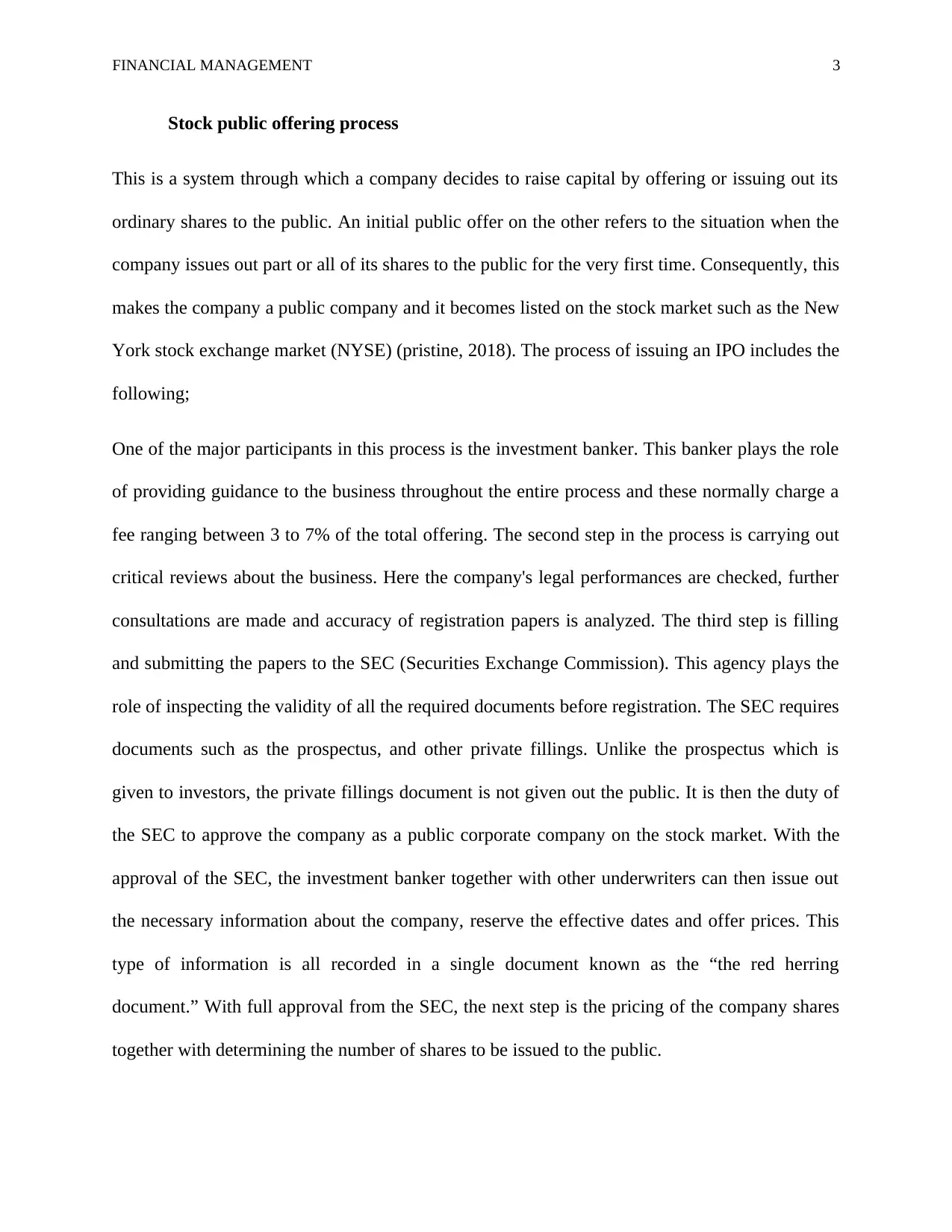
FINANCIAL MANAGEMENT 3
Stock public offering process
This is a system through which a company decides to raise capital by offering or issuing out its
ordinary shares to the public. An initial public offer on the other refers to the situation when the
company issues out part or all of its shares to the public for the very first time. Consequently, this
makes the company a public company and it becomes listed on the stock market such as the New
York stock exchange market (NYSE) (pristine, 2018). The process of issuing an IPO includes the
following;
One of the major participants in this process is the investment banker. This banker plays the role
of providing guidance to the business throughout the entire process and these normally charge a
fee ranging between 3 to 7% of the total offering. The second step in the process is carrying out
critical reviews about the business. Here the company's legal performances are checked, further
consultations are made and accuracy of registration papers is analyzed. The third step is filling
and submitting the papers to the SEC (Securities Exchange Commission). This agency plays the
role of inspecting the validity of all the required documents before registration. The SEC requires
documents such as the prospectus, and other private fillings. Unlike the prospectus which is
given to investors, the private fillings document is not given out the public. It is then the duty of
the SEC to approve the company as a public corporate company on the stock market. With the
approval of the SEC, the investment banker together with other underwriters can then issue out
the necessary information about the company, reserve the effective dates and offer prices. This
type of information is all recorded in a single document known as the “the red herring
document.” With full approval from the SEC, the next step is the pricing of the company shares
together with determining the number of shares to be issued to the public.
Stock public offering process
This is a system through which a company decides to raise capital by offering or issuing out its
ordinary shares to the public. An initial public offer on the other refers to the situation when the
company issues out part or all of its shares to the public for the very first time. Consequently, this
makes the company a public company and it becomes listed on the stock market such as the New
York stock exchange market (NYSE) (pristine, 2018). The process of issuing an IPO includes the
following;
One of the major participants in this process is the investment banker. This banker plays the role
of providing guidance to the business throughout the entire process and these normally charge a
fee ranging between 3 to 7% of the total offering. The second step in the process is carrying out
critical reviews about the business. Here the company's legal performances are checked, further
consultations are made and accuracy of registration papers is analyzed. The third step is filling
and submitting the papers to the SEC (Securities Exchange Commission). This agency plays the
role of inspecting the validity of all the required documents before registration. The SEC requires
documents such as the prospectus, and other private fillings. Unlike the prospectus which is
given to investors, the private fillings document is not given out the public. It is then the duty of
the SEC to approve the company as a public corporate company on the stock market. With the
approval of the SEC, the investment banker together with other underwriters can then issue out
the necessary information about the company, reserve the effective dates and offer prices. This
type of information is all recorded in a single document known as the “the red herring
document.” With full approval from the SEC, the next step is the pricing of the company shares
together with determining the number of shares to be issued to the public.
⊘ This is a preview!⊘
Do you want full access?
Subscribe today to unlock all pages.

Trusted by 1+ million students worldwide
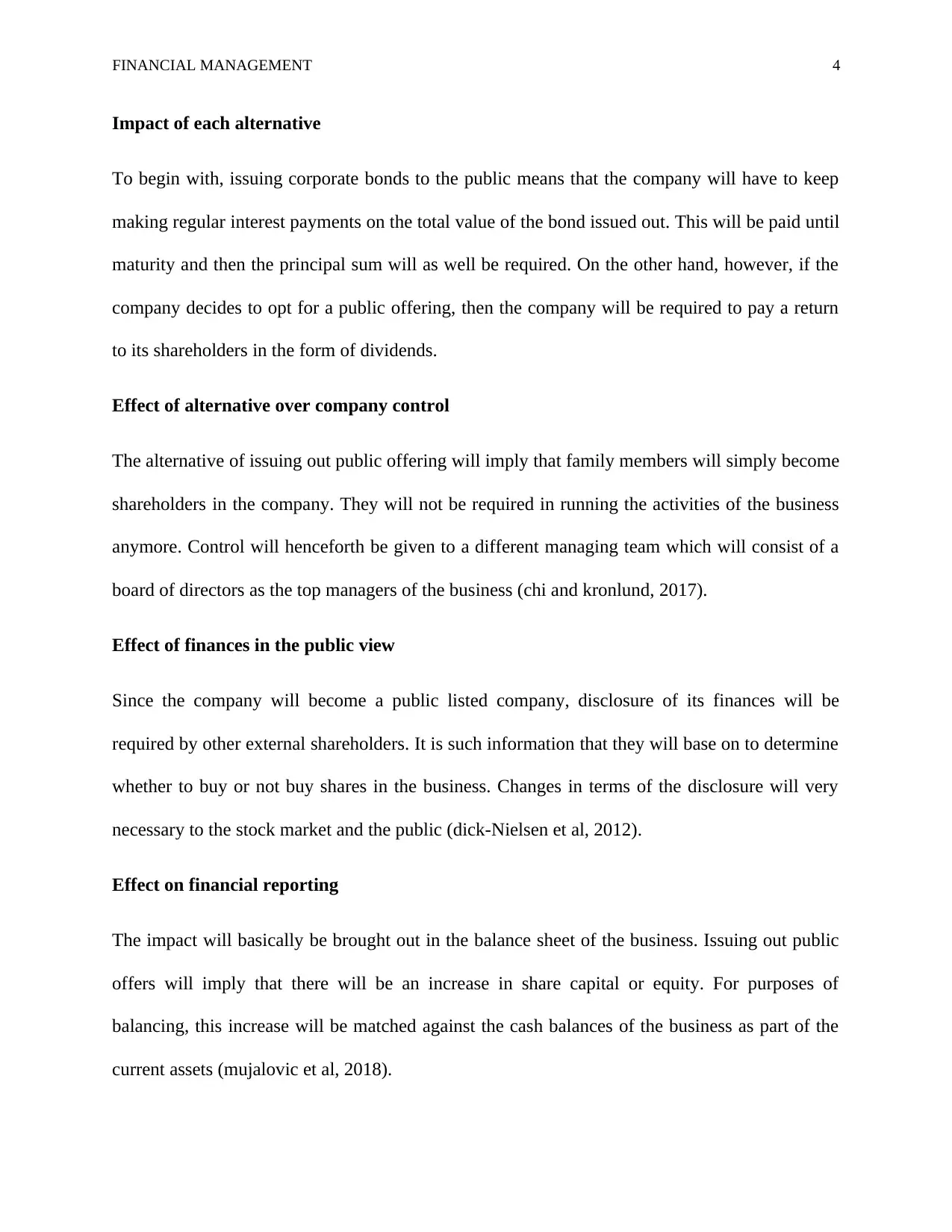
FINANCIAL MANAGEMENT 4
Impact of each alternative
To begin with, issuing corporate bonds to the public means that the company will have to keep
making regular interest payments on the total value of the bond issued out. This will be paid until
maturity and then the principal sum will as well be required. On the other hand, however, if the
company decides to opt for a public offering, then the company will be required to pay a return
to its shareholders in the form of dividends.
Effect of alternative over company control
The alternative of issuing out public offering will imply that family members will simply become
shareholders in the company. They will not be required in running the activities of the business
anymore. Control will henceforth be given to a different managing team which will consist of a
board of directors as the top managers of the business (chi and kronlund, 2017).
Effect of finances in the public view
Since the company will become a public listed company, disclosure of its finances will be
required by other external shareholders. It is such information that they will base on to determine
whether to buy or not buy shares in the business. Changes in terms of the disclosure will very
necessary to the stock market and the public (dick-Nielsen et al, 2012).
Effect on financial reporting
The impact will basically be brought out in the balance sheet of the business. Issuing out public
offers will imply that there will be an increase in share capital or equity. For purposes of
balancing, this increase will be matched against the cash balances of the business as part of the
current assets (mujalovic et al, 2018).
Impact of each alternative
To begin with, issuing corporate bonds to the public means that the company will have to keep
making regular interest payments on the total value of the bond issued out. This will be paid until
maturity and then the principal sum will as well be required. On the other hand, however, if the
company decides to opt for a public offering, then the company will be required to pay a return
to its shareholders in the form of dividends.
Effect of alternative over company control
The alternative of issuing out public offering will imply that family members will simply become
shareholders in the company. They will not be required in running the activities of the business
anymore. Control will henceforth be given to a different managing team which will consist of a
board of directors as the top managers of the business (chi and kronlund, 2017).
Effect of finances in the public view
Since the company will become a public listed company, disclosure of its finances will be
required by other external shareholders. It is such information that they will base on to determine
whether to buy or not buy shares in the business. Changes in terms of the disclosure will very
necessary to the stock market and the public (dick-Nielsen et al, 2012).
Effect on financial reporting
The impact will basically be brought out in the balance sheet of the business. Issuing out public
offers will imply that there will be an increase in share capital or equity. For purposes of
balancing, this increase will be matched against the cash balances of the business as part of the
current assets (mujalovic et al, 2018).
Paraphrase This Document
Need a fresh take? Get an instant paraphrase of this document with our AI Paraphraser
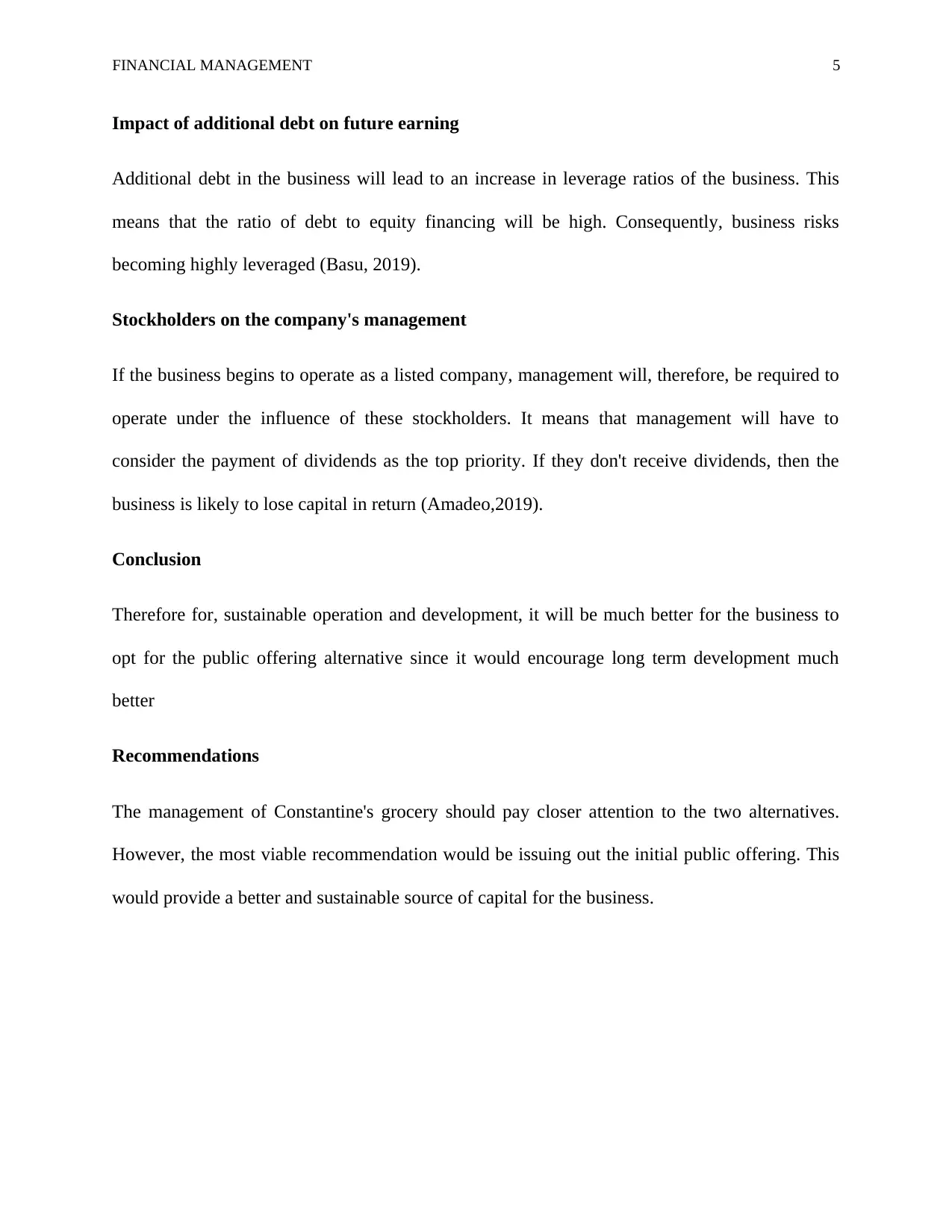
FINANCIAL MANAGEMENT 5
Impact of additional debt on future earning
Additional debt in the business will lead to an increase in leverage ratios of the business. This
means that the ratio of debt to equity financing will be high. Consequently, business risks
becoming highly leveraged (Basu, 2019).
Stockholders on the company's management
If the business begins to operate as a listed company, management will, therefore, be required to
operate under the influence of these stockholders. It means that management will have to
consider the payment of dividends as the top priority. If they don't receive dividends, then the
business is likely to lose capital in return (Amadeo,2019).
Conclusion
Therefore for, sustainable operation and development, it will be much better for the business to
opt for the public offering alternative since it would encourage long term development much
better
Recommendations
The management of Constantine's grocery should pay closer attention to the two alternatives.
However, the most viable recommendation would be issuing out the initial public offering. This
would provide a better and sustainable source of capital for the business.
Impact of additional debt on future earning
Additional debt in the business will lead to an increase in leverage ratios of the business. This
means that the ratio of debt to equity financing will be high. Consequently, business risks
becoming highly leveraged (Basu, 2019).
Stockholders on the company's management
If the business begins to operate as a listed company, management will, therefore, be required to
operate under the influence of these stockholders. It means that management will have to
consider the payment of dividends as the top priority. If they don't receive dividends, then the
business is likely to lose capital in return (Amadeo,2019).
Conclusion
Therefore for, sustainable operation and development, it will be much better for the business to
opt for the public offering alternative since it would encourage long term development much
better
Recommendations
The management of Constantine's grocery should pay closer attention to the two alternatives.
However, the most viable recommendation would be issuing out the initial public offering. This
would provide a better and sustainable source of capital for the business.
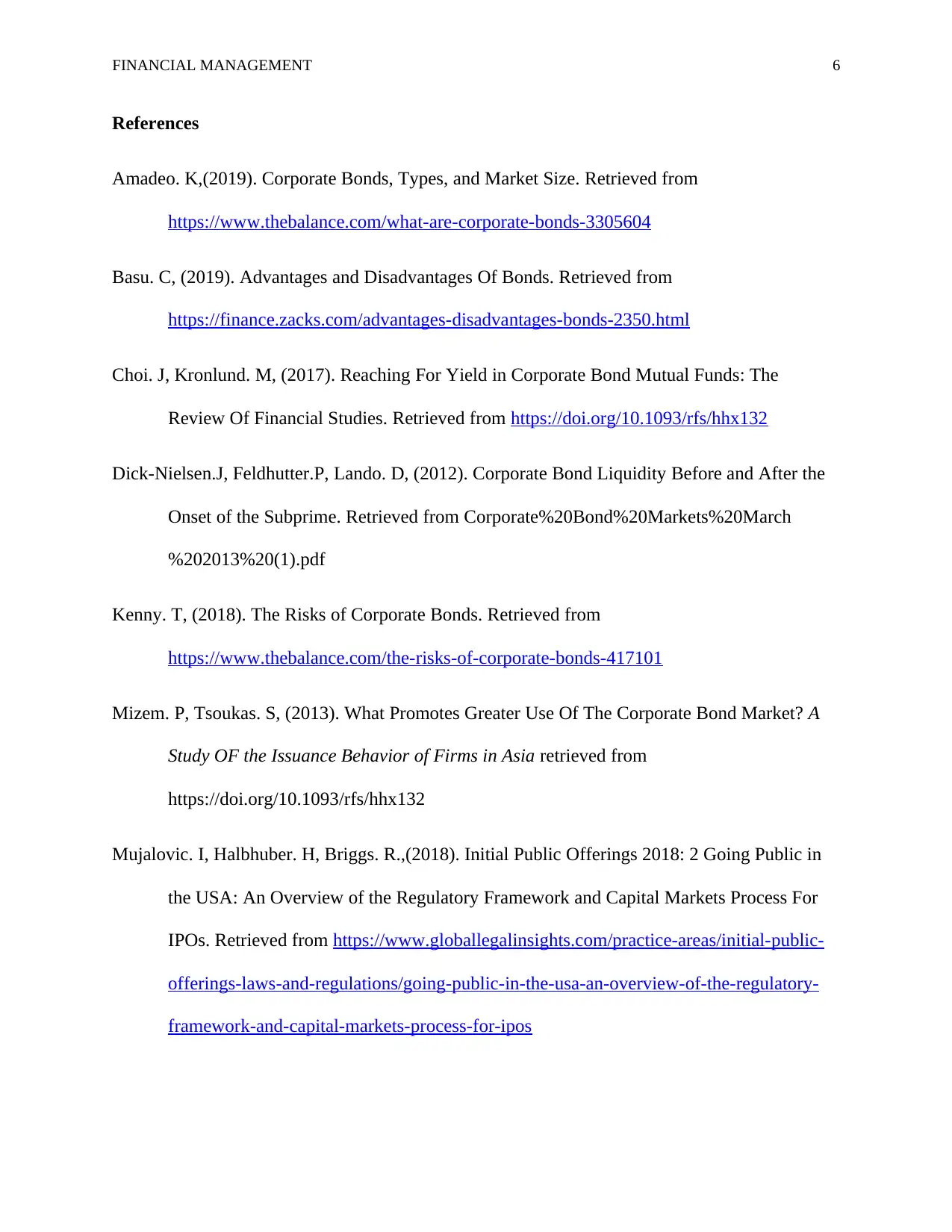
FINANCIAL MANAGEMENT 6
References
Amadeo. K,(2019). Corporate Bonds, Types, and Market Size. Retrieved from
https://www.thebalance.com/what-are-corporate-bonds-3305604
Basu. C, (2019). Advantages and Disadvantages Of Bonds. Retrieved from
https://finance.zacks.com/advantages-disadvantages-bonds-2350.html
Choi. J, Kronlund. M, (2017). Reaching For Yield in Corporate Bond Mutual Funds: The
Review Of Financial Studies. Retrieved from https://doi.org/10.1093/rfs/hhx132
Dick-Nielsen.J, Feldhutter.P, Lando. D, (2012). Corporate Bond Liquidity Before and After the
Onset of the Subprime. Retrieved from Corporate%20Bond%20Markets%20March
%202013%20(1).pdf
Kenny. T, (2018). The Risks of Corporate Bonds. Retrieved from
https://www.thebalance.com/the-risks-of-corporate-bonds-417101
Mizem. P, Tsoukas. S, (2013). What Promotes Greater Use Of The Corporate Bond Market? A
Study OF the Issuance Behavior of Firms in Asia retrieved from
https://doi.org/10.1093/rfs/hhx132
Mujalovic. I, Halbhuber. H, Briggs. R.,(2018). Initial Public Offerings 2018: 2 Going Public in
the USA: An Overview of the Regulatory Framework and Capital Markets Process For
IPOs. Retrieved from https://www.globallegalinsights.com/practice-areas/initial-public-
offerings-laws-and-regulations/going-public-in-the-usa-an-overview-of-the-regulatory-
framework-and-capital-markets-process-for-ipos
References
Amadeo. K,(2019). Corporate Bonds, Types, and Market Size. Retrieved from
https://www.thebalance.com/what-are-corporate-bonds-3305604
Basu. C, (2019). Advantages and Disadvantages Of Bonds. Retrieved from
https://finance.zacks.com/advantages-disadvantages-bonds-2350.html
Choi. J, Kronlund. M, (2017). Reaching For Yield in Corporate Bond Mutual Funds: The
Review Of Financial Studies. Retrieved from https://doi.org/10.1093/rfs/hhx132
Dick-Nielsen.J, Feldhutter.P, Lando. D, (2012). Corporate Bond Liquidity Before and After the
Onset of the Subprime. Retrieved from Corporate%20Bond%20Markets%20March
%202013%20(1).pdf
Kenny. T, (2018). The Risks of Corporate Bonds. Retrieved from
https://www.thebalance.com/the-risks-of-corporate-bonds-417101
Mizem. P, Tsoukas. S, (2013). What Promotes Greater Use Of The Corporate Bond Market? A
Study OF the Issuance Behavior of Firms in Asia retrieved from
https://doi.org/10.1093/rfs/hhx132
Mujalovic. I, Halbhuber. H, Briggs. R.,(2018). Initial Public Offerings 2018: 2 Going Public in
the USA: An Overview of the Regulatory Framework and Capital Markets Process For
IPOs. Retrieved from https://www.globallegalinsights.com/practice-areas/initial-public-
offerings-laws-and-regulations/going-public-in-the-usa-an-overview-of-the-regulatory-
framework-and-capital-markets-process-for-ipos
⊘ This is a preview!⊘
Do you want full access?
Subscribe today to unlock all pages.

Trusted by 1+ million students worldwide
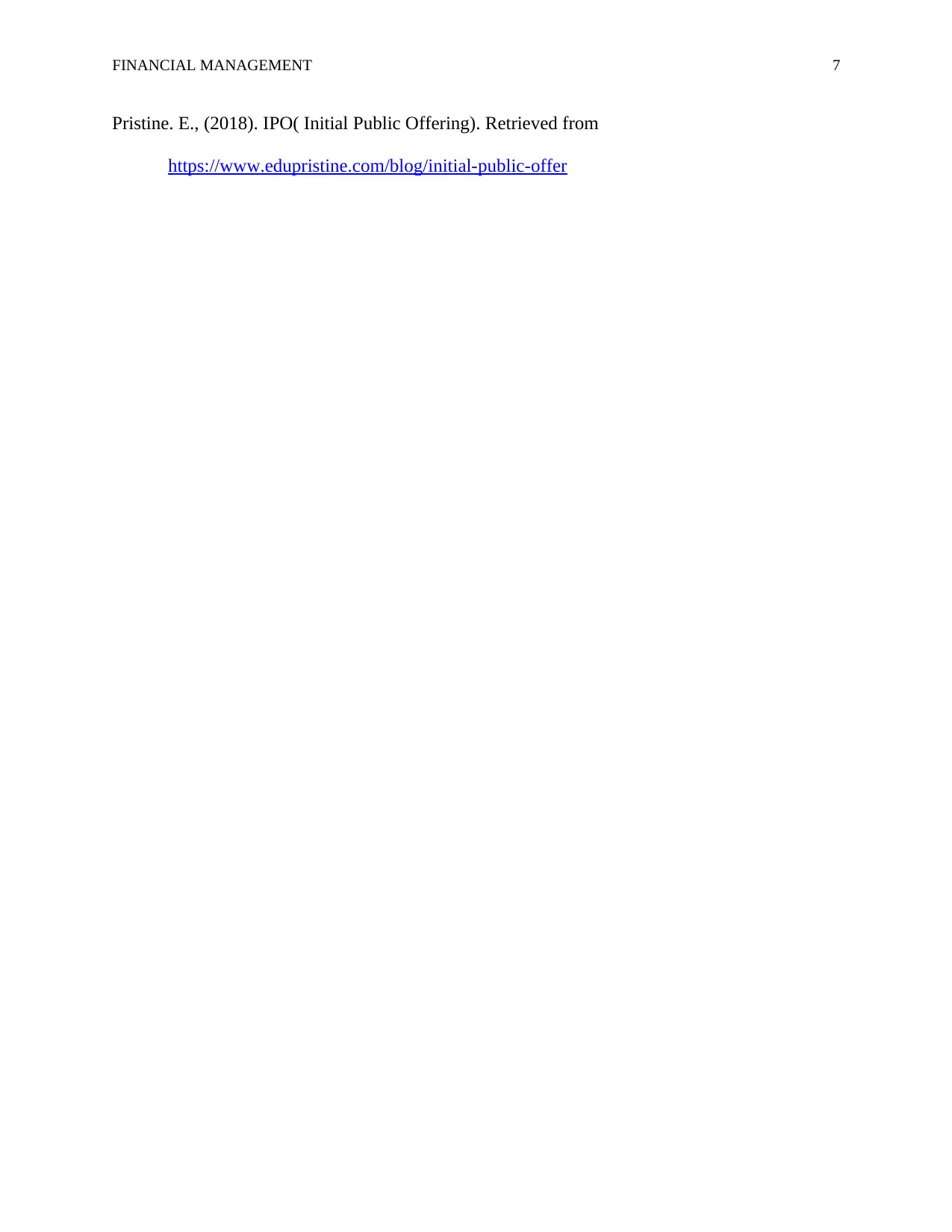
FINANCIAL MANAGEMENT 7
Pristine. E., (2018). IPO( Initial Public Offering). Retrieved from
https://www.edupristine.com/blog/initial-public-offer
Pristine. E., (2018). IPO( Initial Public Offering). Retrieved from
https://www.edupristine.com/blog/initial-public-offer
1 out of 7
Related Documents
Your All-in-One AI-Powered Toolkit for Academic Success.
+13062052269
info@desklib.com
Available 24*7 on WhatsApp / Email
![[object Object]](/_next/static/media/star-bottom.7253800d.svg)
Unlock your academic potential
Copyright © 2020–2025 A2Z Services. All Rights Reserved. Developed and managed by ZUCOL.





